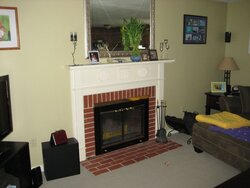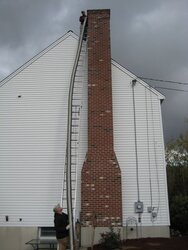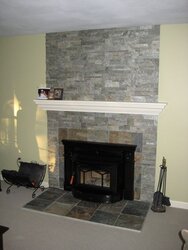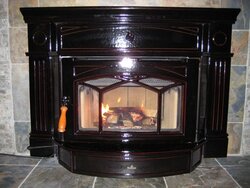nlittle said:
stejus said:
I forgot to ask and I didn't see you mention it. Did the liner get insulated and do you have a cap on that liner?
It does draw well though once it gets going. So, you think I should have one?
By the way, where is your thermometer?
Seeing the chimney is external, it is recommended to have it insulated. The biggest reason is creosote. A warm liner will not allow gases to cool and condense on liner. A cool liner will cool gases off and form more creosote. The second reason is you will get a much better draft. Warm liners draft better. This will allow you to close off the air much sooner reducing the amount of wood you burn. If you have to burn with the air open or 1/2 open to create the draft, you're going though your wood faster.
The insulation I used is called Everguard Insulation Mix. You add water to it, mix it up so it's like damp cat litter and pour it down your chimney. Some don't like to do this in fear of pulling the liner out some day. My sweep told me it can be done, it's just a little messy. I don't plan to remove it. I'll let the next owner deal with it if they want to.
Thermometer - There's some debate on where to put these. I have mine on the top shelf towards the back near the top surround piece. It's the Rutland thermometer. Because the Hampton has a top shelf, the temp is not reflective of what the internal stove temp is. This is due to the space between the shelf and the top of the stove. When you have the blower on, the temp on the shelf gets even lower because your moving heat away from the surface. I really don't use this as a guide anymore, but temps should be above 300 degrees to get effective heat out of the stove.
I've had temps go to 500 but this was with a full load on a bed of coals and the blower off during the first 15 minutes of burning. Once you start to close off the air, you will notice the temp rise because you are letting less heat up the stack. Once you turn the blower on, you will notice the temp falling slowly. The nice thing about the auto blower setting is that it will shut off once the stove is too cool to produce heat. This is a great feature so be sure to use it.
I've been told this Rutland thermometer can scratch the stove surface. It hasn't scratched mine, but mine is a metalic finish. I guess it's the coil on the back side of the Rutland that can flex open and closed and when it's on the surface, it can leave a little scratch. If you do a search, you may find more on this subject.
Unfortunately, the weather is like late November around here. Cold, wet and windy. It's too early for this kind of weather but having the stove create the warm environment makes it all the better. Now we'll just have to wonder what kind of winter we have and will we have enough wood. ;-)








 ! This Hampton insert is the prettiest stove I've ever seen. I'll never forget the first time I saw one of these. It was love at first sight.
! This Hampton insert is the prettiest stove I've ever seen. I'll never forget the first time I saw one of these. It was love at first sight.